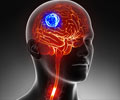Identifying new targets could pave the way for treating a common type of brain cancer known as glioblastoma.

Glioblastoma: The Most Aggressive Type of Brain Cancer
Glioblastoma (as known as Glioblastoma multiforme or GBM) is the most common type of brain cancer in adults. It is also the most challenging to treat due to the resistance of glioblastoma cancer stem cells, from which tumors grow, to therapy. Cancer stem cells that survive after a tumor is treated go on to form new tumors that do not respond to further treatment.‘Fighting Brain Cancer: Glioblastoma’s strength is its adaptability; overcoming it is the greatest challenge. #glioblastoma #braincancer #medindia’





“Glioblastoma tumors have evaded treatment thus far because their composition is highly variable both within and between tumors,” said Graham MacLeod, co-first author on the study and senior research associate of U of T’s Donnelly Centre for Cellular and Biomolecular Research. “The tumors vary quite a bit from person to person, and even within a single tumor there are multiple cell types that harbor differences at the genetic level.” The study was published recently in the journal Cancer Research (1✔ ✔Trusted Source
Fitness Screens Map State-Specific Glioblastoma Stem Cell Vulnerabilities
Go to source).
A key finding of the research is that the variability among glioblastoma cancer stem cells can be observed across a gradient between two cell subtypes. On one end is the developmental subtype, which resembles cells in which normal neurodevelopment has gone awry, and on the other end is the injury-response subtype, which is an inflammatory state. The aim of the study was to identify potential treatment methods to target each subtype, thereby tackling tumors in a more holistic manner.
This study follows earlier research published in Cell Reports that identified vulnerabilities in glioblastoma cancer stem cells that impact their sensitivity to chemotherapy (2✔ ✔Trusted Source
Genome-Wide CRISPR-Cas9 Screens Expose Genetic Vulnerabilities and Mechanisms of Temozolomide Sensitivity in Glioblastoma Stem Cells
Go to source).
The next step within this line of research was to study how vulnerabilities in glioblastoma cancer stem cells vary in a large and diverse set of patient-derived cell lines to identify the most common of these vulnerabilities in each of the subtypes.
Advertisement
CRISPR/Cas9 Screens in Glioblastoma Treatment
The team performed CRISPR/Cas9 screens in glioblastoma stem cell lines from 30 patients, making this the largest screening study of its kind. The patient-derived cell lines were generated by the lab of Peter Dirks, professor of surgery and molecular genetics and Chief of the Division of Neurosurgery at SickKids. Within the cancer stem cell samples, the team found genes responsible for the proliferation of the two cell subtypes that could be targeted to prevent tumor growth. Combining drugs to target both cell subtypes simultaneously could potentially make for a more effective glioblastoma treatment.“A lot of the research on glioblastoma is conducted with a limited number of immortalized cell lines grown in serum,” said Fatemeh Molaei, co-first author on the study and graduate student at the Donnelly Centre and the Leslie Dan Faculty of Pharmacy. “These cells aren’t the best model as they don’t resemble true glioblastoma cells as much as we would like. The findings from our study represent what we see in a patient’s tumor more accurately because our cell lines are derived directly from a large group of patients. It’s through our screens of this group of cell lines that we were able to identify the OLIG2 and MEK genes as drug targets for the developmental cell subtype and the FAK and B1-Integrin genes as targets for the injury-response subtype.”
Advertisement
“In the future, our results will help in designing new treatments that are tailored to patients by targeting the predominant cell subtype, or both subtypes simultaneously,” said Angers, who is also a professor in the Leslie Dan Faculty of Pharmacy and U of T’s Temerty Faculty of Medicine. “The ability of glioblastoma to adapt to therapeutic treatment is its greatest strength and our biggest challenge. Our study increases our understanding of this type of cancer and proposes a different approach to treating it that will hopefully improve the prognosis of patients.”
Reference:
- Fitness Screens Map State-Specific Glioblastoma Stem Cell Vulnerabilities - (https://aacrjournals.org/cancerres/article-abstract/doi/10.1158/0008-5472.CAN-23-4024/747393/Fitness-Screens-Map-State-Specific-Glioblastoma)
- Genome-Wide CRISPR-Cas9 Screens Expose Genetic Vulnerabilities and Mechanisms of Temozolomide Sensitivity in Glioblastoma Stem Cells - (https://www.sciencedirect.com/science/article/pii/S2211124719303638)
Source-Eurekalert














